Prediction of Potential Suitable Areas and Distribution Evolution of Phoebe zhennan under Different Climate Scenarios
Abstract
:1. Introduction
2. Materials and Methods
2.1. Species Data
2.2. Climate Data
2.3. Geographic Data
2.4. MaxEnt Ecological Niche Model
3. Results
3.1. Potential Suitable Areas for P. zhennan under Climatic Conditions Only
3.1.1. Predicted Results of Potential Suitable Areas for P. zhennan
3.1.2. Evaluation Indicators for the Prediction of Suitable Areas for P. zhennan
3.1.3. Analysis of Environmental Factors for the Prediction of P. zhennan’s Suitable Areas
3.2. Potential Suitable Areas for P. zhennan under Climatic and Geographical Conditions
3.2.1. Predicted Results of Potential Suitable Areas for P. zhennan
3.2.2. Evaluation Indicators for the Prediction of Suitable Areas for P. zhennan
3.2.3. Analysis of Environmental Factors for the Prediction of P. zhennan’s Suitable Areas
4. Discussion
4.1. Accuracy and Stability of the Predicted Results of the Model for the Potential Suitable Areas for P. zhennan
4.2. Analysis of Potential Suitable Areas for P. zhennan for Different Environmental Factors
4.3. Migration Paths of P. zhennan’s Potential Suitable Areas
5. Conclusions
Author Contributions
Funding
Institutional Review Board Statement
Informed Consent Statement
Data Availability Statement
Acknowledgments
Conflicts of Interest
References
- Lambert, A.M.; Miller-Rushing, A.J.; Inouye, D.W. Changes in snowmelt date and summer precipitation affect the flowering phenology of Erythronium grandiflorum (glacier lily; Liliaceae). Am. J. Bot. 2010, 97, 1431–1437. [Google Scholar] [CrossRef]
- Xu, K.; Wang, X.; Jiang, C.; Sun, O.J. Assessing the vulnerability of ecosystems to climate change based on climate exposure, vegetation stability and productivity. For. Ecosyst. 2020, 7, 315–326. [Google Scholar] [CrossRef]
- Gou, L.; Xiao, J.; Huang, J.; Ying, L.; Wei, Y.; Peng, C.; Luo, M. Soil fauna community after removal of litter and herb layers in an artificial Phoebe zhennan plantation. J. Zhejiang A F Univ. 2017, 34, 895–906. [Google Scholar] [CrossRef]
- Moriuchi, K.S.; Winn, A.A. Relationships among growth, development and plastic response to environment quality in a perennial plant. New Phytol. 2005, 166, 149–158. [Google Scholar] [CrossRef]
- Hu, S.K.; Liu, C.; Wei, P.J.; Li, M.; Hu, D. Community characteristics of the wild Phoebe and Machilus plants in Yuan’an County, Hubei Province. J. Zhejiang A F Univ. 2020, 37, 702–709. [Google Scholar] [CrossRef]
- Zhao, Y.; Xiao, D.; Bai, H.; Tao, F. Research progress on the response and adaptation of crop phenology to climate change in China. Prog. Geogr. 2019, 38, 224–235. [Google Scholar] [CrossRef]
- Zhou, R.; Ci, X.; Xiao, J.; Cao, G.; Li, J. Effects and conservation assessment of climate change on the dominant group—The genus Cinnamomum of subtropical evergreen broad-leaved forests. Biodivers. Sci. 2021, 29, 697–711. [Google Scholar] [CrossRef]
- Zhu, G.; Liu, G.; Bu, W.; Gao, Y. Ecological niche modeling and its applications in biodiversity conservation. Biodivers. Sci. 2013, 21, 90–98. [Google Scholar] [CrossRef]
- Sutherst, R.W.; Maywald, G.F. A computerised system for matching climates in ecology. Agric. Ecosyst. Environ. 1985, 13, 281–299. [Google Scholar] [CrossRef]
- Honig, M.A.; Cowling, R.M.; Richardson, D.M. The invasive potential of Australian banksias in South African fynbos: A comparison of the reproductive potential of Banksia ericifolia and Leucadendron laureolum. Austral Ecol. 1992, 17, 305–314. [Google Scholar] [CrossRef]
- Carpenter, G.; Gillison, A.N.; Winter, J. DOMAIN: A flexible modelling procedure for mapping potential distributions of plants and animals. Biodivers. Conserv. 1993, 2, 667–680. [Google Scholar] [CrossRef]
- Phillips, S.J.; Dudík, M.; Schapire, R.E. A maximum entropy approach to species distribution modeling. In Proceedings of the Twenty-First International Conference on Machine Learning, Banff, AB, Canada, 4–8 July 2004; p. 83. [Google Scholar] [CrossRef]
- Shen, S.; Zheng, F.; Zhang, W.; Xu, G.; Li, D.; Yang, S.; Jin, G.; Clements, D.R.; Nikkel, E.; Chen, A.; et al. Potential distribution and ecological impacts of Acmella radicans (Jacquin) R.K. Jansen (a new Yunnan invasive species record) in China. BMC Plant Biol. 2024, 24, 494. [Google Scholar] [CrossRef]
- Zhang, Y.; Tang, J.; Ren, G.; Zhao, K.; Wang, X. Global potential distribution prediction of Xanthium italicum based on Maxent model. Sci. Rep. 2021, 11, 16545. [Google Scholar] [CrossRef]
- Song, X.; Milne, R.I.; Fan, X.; Xie, S.; Zhang, L.; Zheng, H.; Fan, L.; Chung, J.M.; Chung, M.G.; Ma, T.; et al. Blow to the Northeast? Intraspecific differentiation of Populus davidiana suggests a north-eastward skew of a phylogeographic break in East Asia. J. Biogeogr. 2020, 48, 187–201. [Google Scholar] [CrossRef]
- Phillips, S.; Dudík, M. Modeling of species distributions with MAXENT: New extensions and a comprehensive evaluation. Ecography 2008, 31, 161–175. [Google Scholar] [CrossRef]
- Chen, K.; Wang, B.; Chen, C.; Zhou, G.-y. MaxEnt Modeling to Predict the Current and Future Distribution of Pomatosace filicula under Climate Change Scenarios on the Qinghai–Tibet Plateau. Plants 2022, 11, 670. [Google Scholar] [CrossRef]
- Liu, L.; Guan, L.; Zhao, H.; Huang, Y.; Mou, Q.; Liu, K.; Chen, T.; Wang, X.; Zhang, Y.; Wei, B.; et al. Modeling habitat suitability of Houttuynia cordata Thunb (Ceercao) using MaxEnt under climate change in China. Ecol. Inform. 2021, 63, 101324. [Google Scholar] [CrossRef]
- Zhou, Y.; Zhang, Z.-X.; Zhu, B.; Cheng, X.-R.; Yang, L.; Gao, M.; Kong, R. MaxEnt Modeling Based on CMIP6 Models to Project Potential Suitable Zones for Cunninghamia lanceolata in China. Forests 2021, 12, 752. [Google Scholar] [CrossRef]
- Li, D.; Li, B.; Hou, X.; Wang, X.; Li, X.; Zhang, Y. Habitat suitability assessment for Saunders’s Gull (Saundersilarus saundersi) in the Yellow River Delta, China. Ecol. Inform. 2024, 79, 102393. [Google Scholar] [CrossRef]
- Yang, S.Y.; An, M.T.; Liu, F.; Zhang, Y.; Tian, L.; Chen, C.Y. Prediction of potential suitable area of Phoebe zhennan in Guizhou Province based on MaxEnt model. Guihaia 2023, 43, 846–857. [Google Scholar] [CrossRef]
- Huang, C.; Zhu, S.; Hu, D. Investigation into the Wild Phoebe Resources in Xingshan County, Hubei Province. J. Yunnan Agric. Univ. (Nat. Sci.) 2018, 33, 721–728. [Google Scholar] [CrossRef]
- CVH. Available online: https://www.cvh.ac.cn/species/taxon_tree.php (accessed on 18 February 2024).
- WorldClim. Available online: https://worldclim.org/data/index.html (accessed on 18 February 2024).
- Luo, J.J.; Tang, W.-Z.; Ding, J.T. Research of ATC Simulator Training Values Independence Based on Pearson Correlation Coefficient and Study of Data Visualization Based on Factor Analysis. Comput. Sci. 2021, 48, 623–628. [Google Scholar] [CrossRef]
- Lai, W.; Shi, C.; Wen, G.; Lu, Z.; Ye, L.; Huang, Q.; Zhang, G. Potential impacts of climate change on the distribution of the relict plant Shaniodendron subaequale. Heliyon 2023, 9, e14402. [Google Scholar] [CrossRef]
- Mahmoodi, S.; Heydari, M.; Ahmadi, K.; Khwarahm, N.R.; Karami, O.; Almasieh, K.; Naderi, B.; Bernard, P.; Mosavi, A. The current and future potential geographical distribution of Nepeta crispa Willd., an endemic, rare and threatened aromatic plant of Iran: Implications for ecological conservation and restoration. Ecol. Indic. 2022, 137, 108752. [Google Scholar] [CrossRef]
- Wang, Y.; Zhao, R.; Zhou, X.; Zhang, X.; Zhao, G.; Zhang, F. Prediction of potential distribution areas and priority protected areas of Agastache rugosa based on Maxent model and Marxan model. Front. Plant Sci. 2023, 14, 1200796. [Google Scholar] [CrossRef]
- Yang, F.; Zhang, X.; Li, Z. Spatial differentiation of the “production-life-ecology”competitiveness in urban tourism: A case study of five provinces in northwest China. Arid Land Geogr. 2019, 42, 664–672. [Google Scholar] [CrossRef]
- Li, N.; Xu, G. Grid analysis of land use based on natural breaks (jenks) classification. Bull. Surv. 2020, 106–110+156. [Google Scholar] [CrossRef]
- Lu, Y.; Xiang, P.A.; Yu, L. Agglomeration and spatial dependence of organic agriculture in China. Chin. J. Eco-Agric. 2021, 29, 440–452. [Google Scholar] [CrossRef]
- Zhu, X.; Liu, T.; Xu, K.; Chen, C. The impact of high temperature and drought stress on the yield of major staple crops in northern China. J. Environ. Manag. 2022, 314, 115092. [Google Scholar] [CrossRef]
- Xie, C.; Li, M.; Jim, C.Y.; Liu, D. Environmental Factors Driving the Spatial Distribution Pattern of Venerable Trees in Sichuan Province, China. Plants 2022, 11, 3581. [Google Scholar] [CrossRef]
- Ding, X.; Xiao, J.H.; Huang, J.F.; Li, J. Investigation on Wild Resource of Valuable Timber Tree Phoebe zhennan (Lauraceae). Plant Divers. Resour. 2015, 37, 629–639. [Google Scholar] [CrossRef]
- Weng, Y.; Cai, W.; Wang, C. The application and future directions of the Shared Socioeconomic Pathways (SSPs). Clim. Chang. Res. 2020, 16, 215–222. [Google Scholar] [CrossRef]

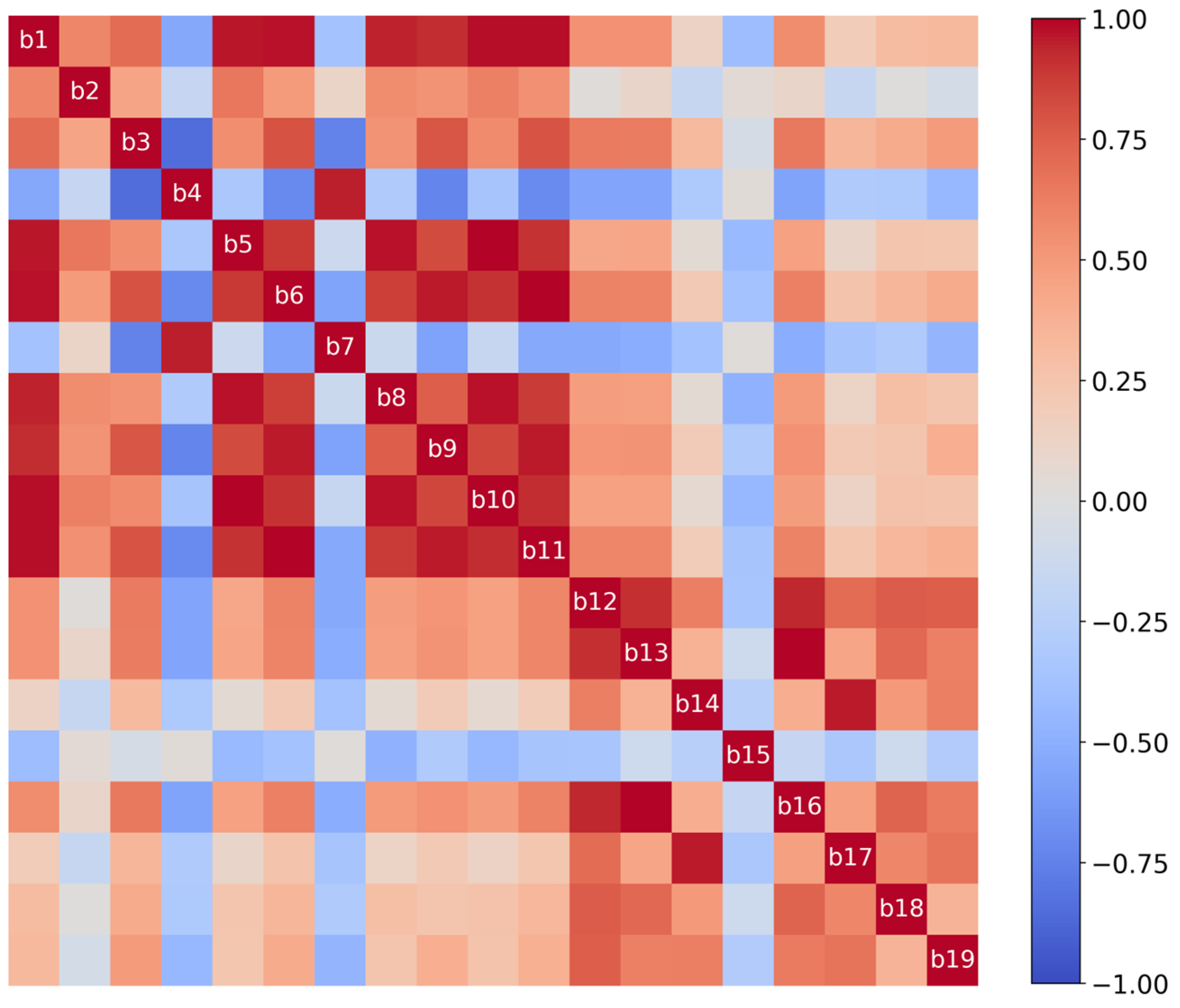

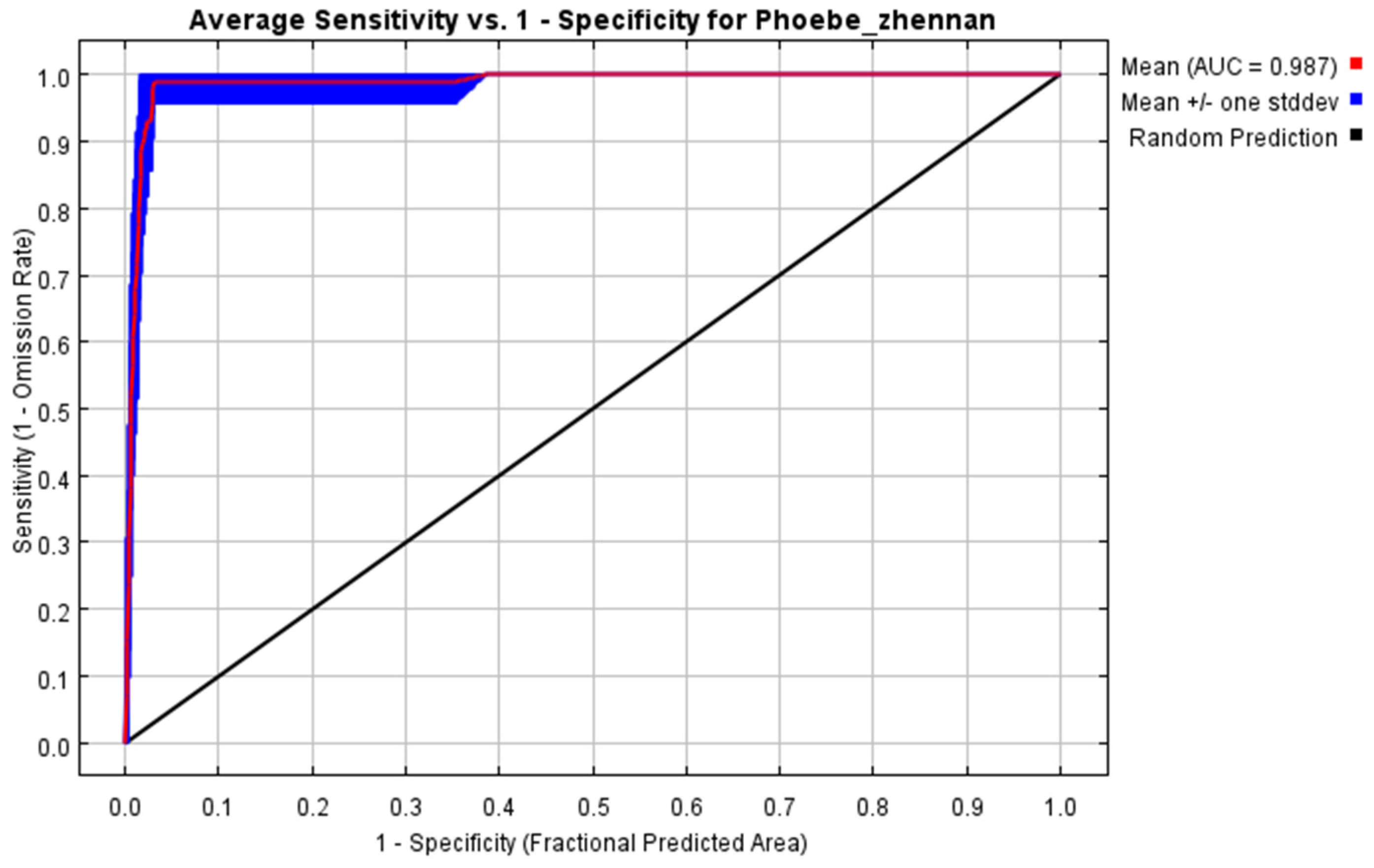

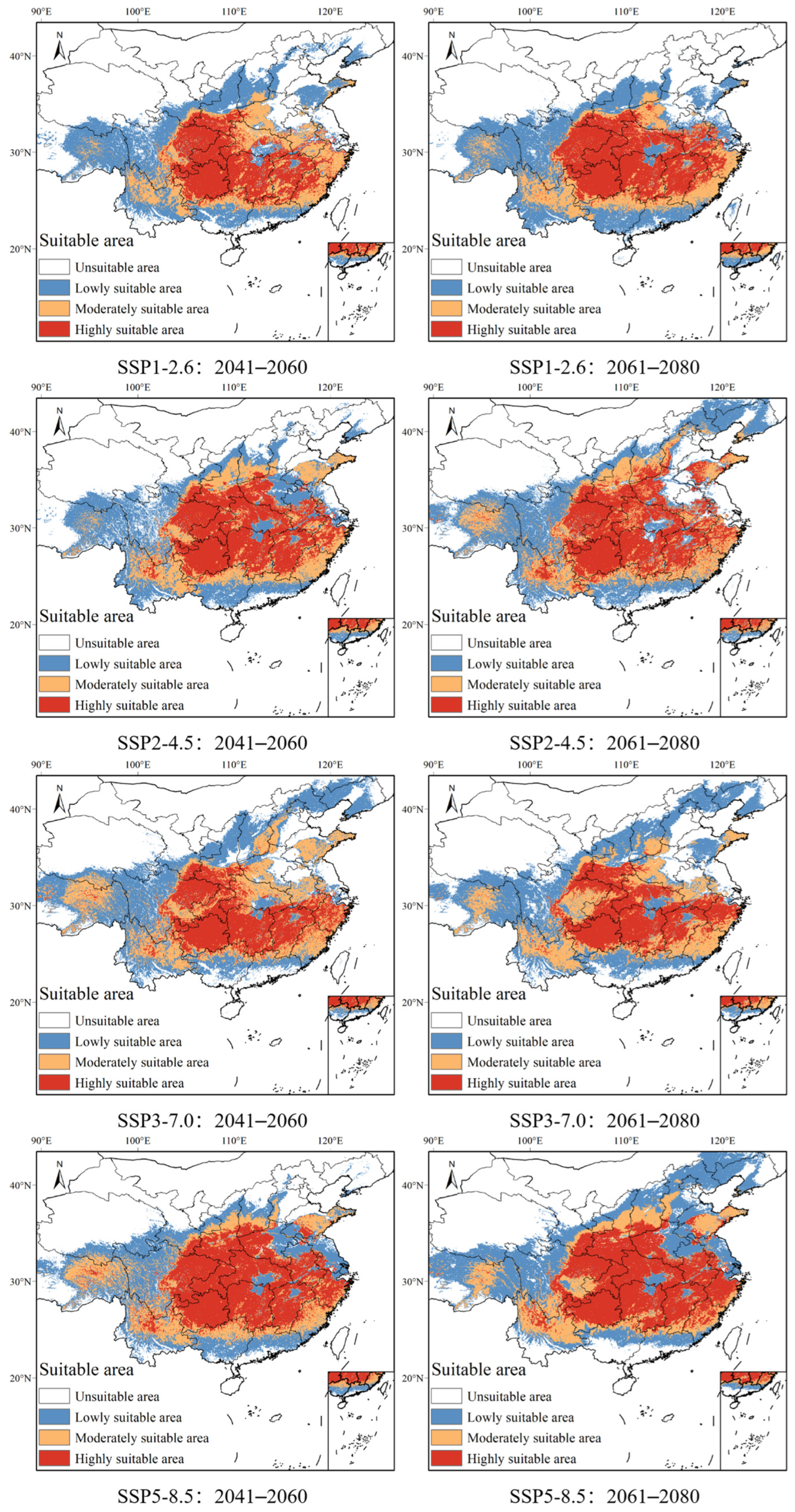


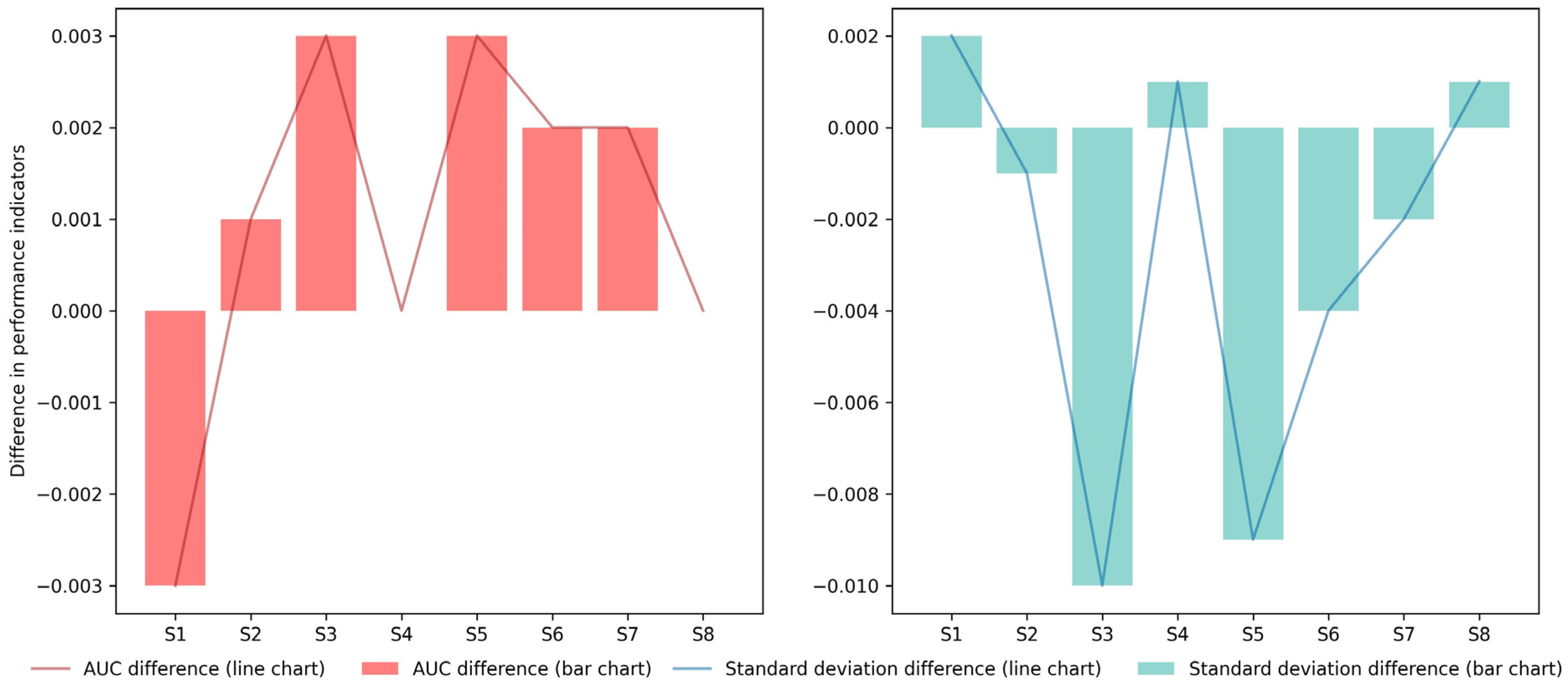



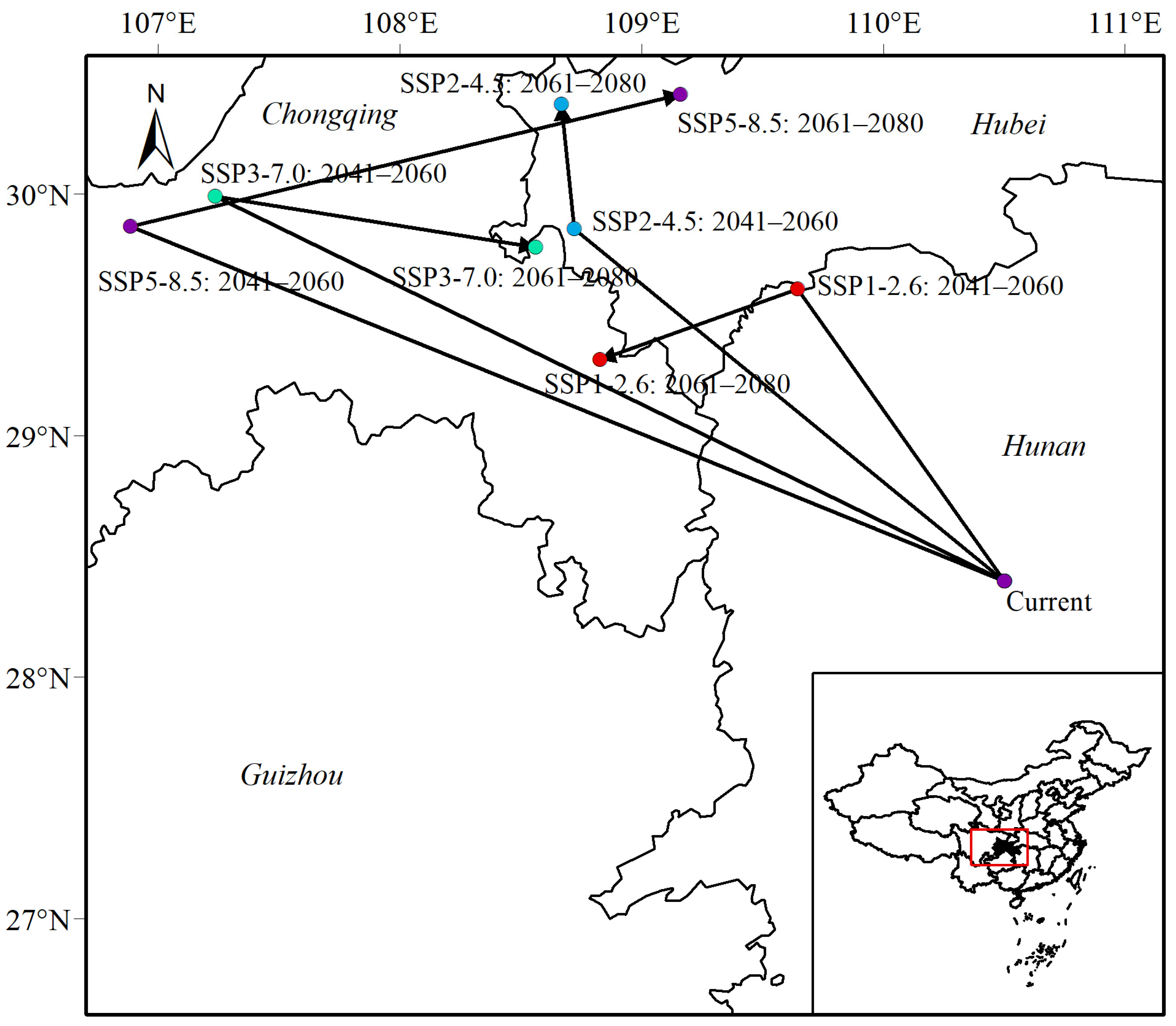
| Code of Factor | Description for Factor (Unit) |
|---|---|
| b1 | Annual Mean Temperature (°C) |
| b2 | Mean Diurnal Range (°C) |
| b3 | Isothermality |
| b4 | Temperature Seasonality |
| b5 | Max Temperature of the Warmest Month (°C) |
| b6 | Min Temperature of the Coldest Month (°C) |
| b7 | Temperature Annual Range (°C) |
| b8 | Mean Temperature of the Wettest Quarter (°C) |
| b9 | Mean Temperature of the Driest Quarter (°C) |
| b10 | Mean Temperature of the Warmest Quarter (°C) |
| b11 | Mean Temperature of the Coldest Quarter (°C) |
| b12 | Annual Precipitation (mm) |
| b13 | Precipitation of the Wettest Month (mm) |
| b14 | Precipitation of the Driest Month (mm) |
| b15 | Precipitation Seasonality (mm) |
| b16 | Precipitation of the Wettest Quarter (mm) |
| b17 | Precipitation of the Driest Quarter (mm) |
| b18 | Precipitation of the Warmest Quarter (mm) |
| b19 | Precipitation of Coldest Quarter (mm) |
| Circumstances | Lowly Suitable Area | Moderately Suitable Area | Highly Suitable Area | Total |
|---|---|---|---|---|
| CURRENT | 87.967 | 73.651 | 68.2934 | 229.9114 |
| SSP1-2.6:2041–2060 | 81.0347 | 68.3038 | 77.533 | 226.8715 |
| SSP1-2.6:2061–2080 | 85.533 | 89.2049 | 71.0191 | 245.757 |
| SSP2-4.5:2041–2060 | 86.2153 | 81.059 | 88.7205 | 255.9948 |
| SSP2-4.5:2061–2080 | 73.3194 | 69.3455 | 99.9479 | 242.6128 |
| SSP3-7.0:2041–2060 | 75.5625 | 92.1649 | 62.7361 | 230.4635 |
| SSP3-7.0:2061–2080 | 92.8021 | 86.3142 | 71.3524 | 250.4687 |
| SSP5-8.5:2041–2060 | 75.7118 | 87.0851 | 85.8924 | 248.6893 |
| SSP5-8.5:2061–2080 | 98.342 | 85.4427 | 55.8542 | 239.6389 |
| Circumstances | AUC Value | Standard Deviation |
|---|---|---|
| SSP1-2.6:2041–2060 | 0.991 | 0.005 |
| SSP1-2.6:2061–2080 | 0.987 | 0.013 |
| SSP2-4.5:2041–2060 | 0.988 | 0.009 |
| SSP2-4.5:2061–2080 | 0.989 | 0.009 |
| SSP3-7.0:2041–2060 | 0.988 | 0.014 |
| SSP3-7.0:2061–2080 | 0.988 | 0.011 |
| SSP5-8.5:2041–2060 | 0.990 | 0.005 |
| SSP5-8.5:2061–2080 | 0.989 | 0.007 |
| Circumstances | Lowly Suitable Area | Moderately Suitable Area | Highly Suitable Area | Total |
|---|---|---|---|---|
| CURRENT | 81.4757 | 65.3281 | 55.7899 | 202.5937 |
| SSP1-2.6:2041–2060 | 127.604 | 80.1632 | 85.2951 | 293.0623 |
| SSP1-2.6:2061–2080 | 129.977 | 72.9288 | 102.698 | 305.6038 |
| SSP2-4.5:2041–2060 | 120.139 | 84.6806 | 105.323 | 310.1426 |
| SSP2-4.5:2061–2080 | 135.342 | 93.0434 | 112.932 | 341.3174 |
| SSP3-7.0:2041–2060 | 142.601 | 103.099 | 88.7483 | 334.4483 |
| SSP3-7.0:2061–2080 | 140.292 | 91.0052 | 83.533 | 314.8302 |
| SSP5-8.5:2041–2060 | 118.556 | 87.1094 | 128.509 | 334.1744 |
| SSP5-8.5:2061–2080 | 153.339 | 82.9427 | 130.125 | 366.4067 |
| Circumstances | AUC Value | Standard Deviation |
|---|---|---|
| SSP1-2.6:2041–2060 | 0.988 | 0.007 |
| SSP1-2.6:2061–2080 | 0.990 | 0.004 |
| SSP2-4.5:2041–2060 | 0.989 | 0.008 |
| SSP2-4.5:2061–2080 | 0.991 | 0.005 |
| SSP3-7.0:2041–2060 | 0.991 | 0.004 |
| SSP3-7.0:2061–2080 | 0.990 | 0.009 |
| SSP5-8.5:2041–2060 | 0.990 | 0.006 |
| SSP5-8.5:2061–2080 | 0.989 | 0.008 |
Disclaimer/Publisher’s Note: The statements, opinions and data contained in all publications are solely those of the individual author(s) and contributor(s) and not of MDPI and/or the editor(s). MDPI and/or the editor(s) disclaim responsibility for any injury to people or property resulting from any ideas, methods, instructions or products referred to in the content. |
© 2024 by the authors. Licensee MDPI, Basel, Switzerland. This article is an open access article distributed under the terms and conditions of the Creative Commons Attribution (CC BY) license (https://creativecommons.org/licenses/by/4.0/).
Share and Cite
Mao, B.; Zhu, Y. Prediction of Potential Suitable Areas and Distribution Evolution of Phoebe zhennan under Different Climate Scenarios. Sustainability 2024, 16, 7971. https://doi.org/10.3390/su16187971
Mao B, Zhu Y. Prediction of Potential Suitable Areas and Distribution Evolution of Phoebe zhennan under Different Climate Scenarios. Sustainability. 2024; 16(18):7971. https://doi.org/10.3390/su16187971
Chicago/Turabian StyleMao, Bo, and Yingfang Zhu. 2024. "Prediction of Potential Suitable Areas and Distribution Evolution of Phoebe zhennan under Different Climate Scenarios" Sustainability 16, no. 18: 7971. https://doi.org/10.3390/su16187971






